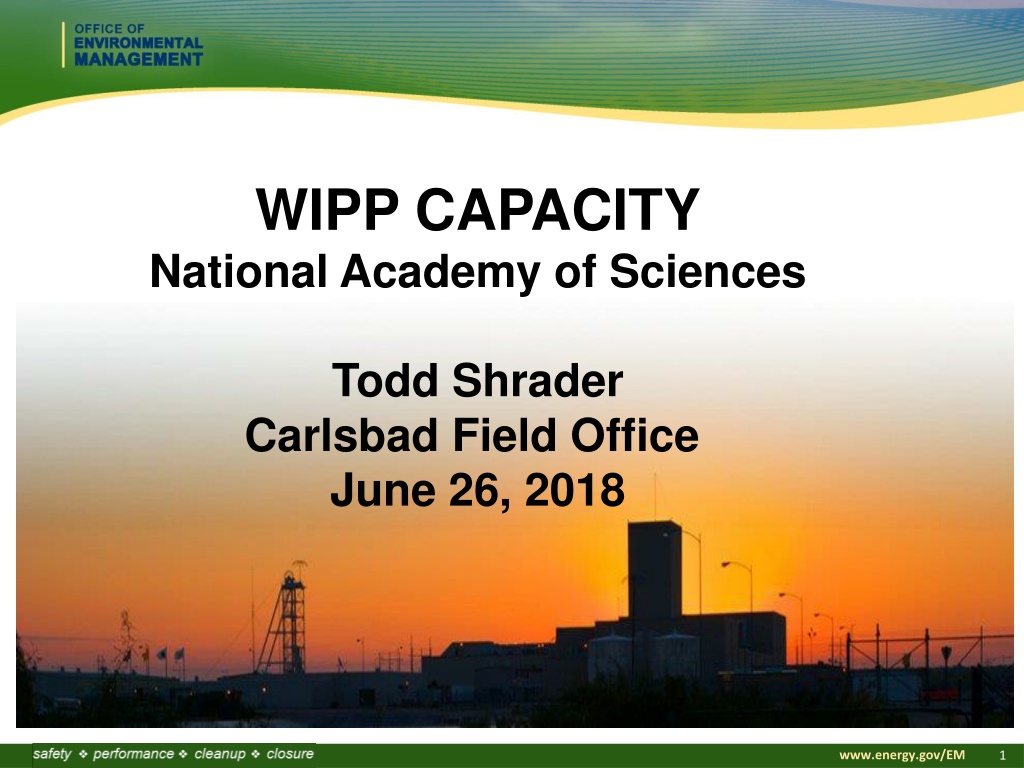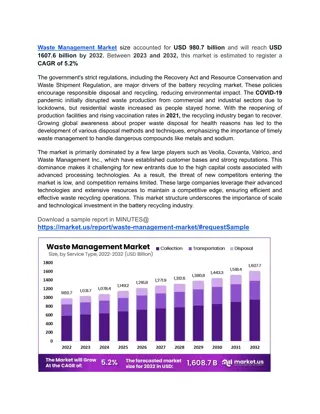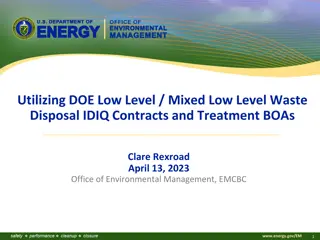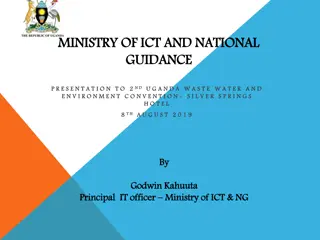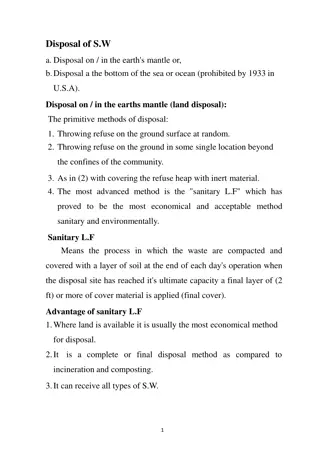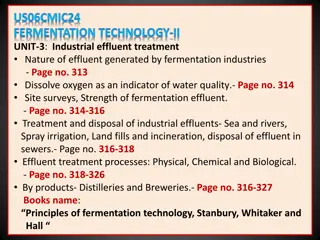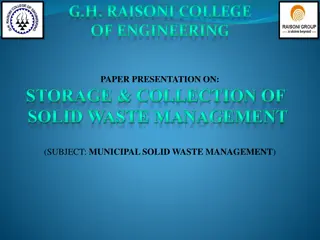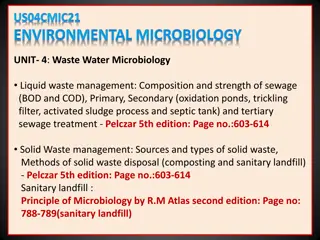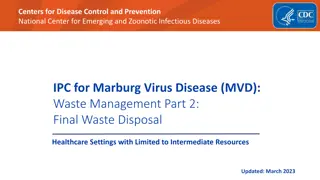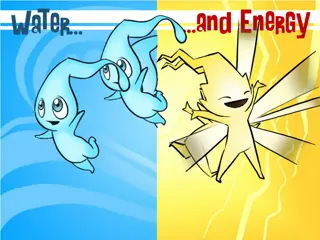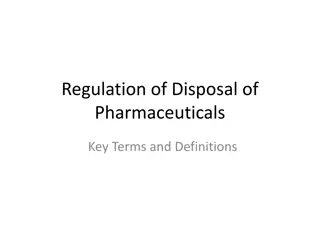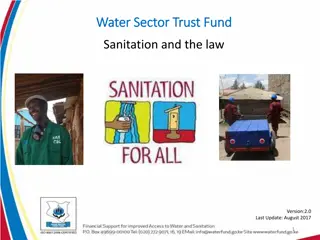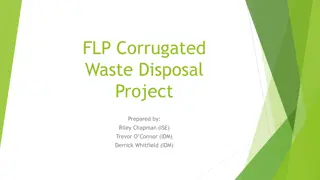WIPP Waste Disposal Capacity Overview
The Waste Isolation Pilot Plant (WIPP) has a statutory capacity of up to 175,565 cubic meters for disposal of transuranic waste. As of June 2018, 93,500 cubic meters of TRU waste have been emplaced at WIPP. The facility operates within the 16 square mile land withdrawal boundary specified by the WIPP Land Withdrawal Act. Learn about the regulatory capacity, volume calculations, projected volumes, and more concerning the WIPP disposal operations.
Download Presentation

Please find below an Image/Link to download the presentation.
The content on the website is provided AS IS for your information and personal use only. It may not be sold, licensed, or shared on other websites without obtaining consent from the author.If you encounter any issues during the download, it is possible that the publisher has removed the file from their server.
You are allowed to download the files provided on this website for personal or commercial use, subject to the condition that they are used lawfully. All files are the property of their respective owners.
The content on the website is provided AS IS for your information and personal use only. It may not be sold, licensed, or shared on other websites without obtaining consent from the author.
E N D
Presentation Transcript
WIPP CAPACITY National Academy of Sciences Todd Shrader Carlsbad Field Office June 26, 2018 www.energy.gov/EM 1
WIPP Statutory Capacity The WIPP Land Withdrawal Act (LWA), Public Law 102-579, authorizes WIPP for disposal of up to 175,565 cubic meters (6.2 million cubic feet) of transuranic (TRU) waste. Up to 7,079 cubic meters (250,000 cubic feet) of TRU waste can be remote handled DOE 1981 & 1998 ROD, and 1997 SEIS-II. Drums and boxes assumed to be full, based on inventory estimates from late 1970 s & early 1980. Although recognized as a possibility, overpack was not assumed. Volume was based on original 1980 assumptions of TRU waste in interim storage in Idaho, an enduring mission at Rocky Flats and continued plutonium missions at Hanford and Savannah River. There is no specific disposal configuration specified in the LWA other than the requirement to stay within the 16 square mile land withdrawal boundary. LWA Sec. 7(3) CAPACITY OF WIPP. The total capacity of WIPP by volume is 6.2 million cubic feet of transuranic waste. As of June, 2018 93,500 cubic meters of TRU waste emplaced in WIPP. www.energy.gov/EM 2
WIPP Statutory Capacity Less than one square mile at a single horizon has been used thus far. www.energy.gov/EM 3
Panel Regulatory Capacity For operational efficiencies, WIPP handles all TRU waste as mixed TRU waste Each Hazardous Waste Disposal Unit (Panel 1-8) was permitted for 18,000-19,400 cubic meters of TRU mixed waste. Panel 9 not planned for disposal. Panel 10 may be used but must be permitted by the state for use. Per the WIPP Hazardous Waste Facility Permit, The maximum repository capacity of 6.2 million cubic feet of transuranic waste is specified in the WIPP Land Withdrawal Act (Pub. L. 102-579, as amended) It is estimated that after Panel 8 is filled, the emplaced WIPP repository volume will be 115,000 to 120,000 cubic meters. www.energy.gov/EM 4
WIPP Volume Capacity--Current and Projected Volumes Current Permit Calculates Volume of Outer Container Cubic meters (m3) 93,500 Permit Modification-- Changes Volume of Record to Inner Container (m3) ~-30% TRU Waste Inventories Notes WDS data through mid-June TRU Waste Already Emplaced at WIPP Data cutoff 12/31/16; Includes 6 metric tons (MT) of surplus Pu~5K m3; Source: DOE/TRU-17-3425 "WIPP-Bound" Best Estimates ** ~78K ~-15% SubTotal: Already Emplaced + WIPP-Bound UNSUBSCRIBED CAPACITY ~172K Volume below WIPP LWA Limit of 175,565 m3 ~4K >40K Data cutoff 12/31/16; Source: DOE/TRU-17-3425 "Potential Inventory" Estimates** ~19K 191K 40K = ~150K Total Emplaced, WIPP-Bound, and Potential Waste** ~191K ~150K ** Estimates will vary as estimates are updated and waste is packaged. Definitions: WIPP-Bound this is waste already in storage or projected to be generated in the future and is expected to meet the WIPP waste acceptance criteria, currently totaling approximately 78,000 m3; Potential Waste this is waste that may be intended for WIPP but requires resolution of a regulatory or other constraint before it may be considered, currently totaling approximately 19,000 m3; and www.energy.gov/EM 5
WIPP Volume of Record Volume of Record to track compliance with this limit has generally been determined by using the outer container volume for CH-TRU waste. Because many drums are overpacked in larger containers, using the outer container volume counts a significant amount of void space as waste. DOE/CBFO proposes to change the calculation method so the Volume of Record better reflects the volume of waste disposed. For tracking the TRU waste volume with WIPP LWA capacity limit the new methodology will count the volume of the inner container in cases where CH TRU waste is overpacked. The waste volume of direct loaded containers will continue to be the outer container. For compliance with the RCRA Hazardous Waste Facility Permit, the outer container is proposed. Under the new methodology, the calculated volume of waste already emplaced is reduced by about 30%, and future WIPP-bound waste by 15%. www.energy.gov/EM 6
VOR Permit Modification Request Process NMED determined the PMR will follow the Class 3 PMR procedures, which consists of the following major steps; NMED will likely provide a Technical Incompleteness Determination (TID). WIPP responds to the TID. NMED prepares a draft Permit. Minimum 45-day public comment period on the draft Permit. May include Negotiation. May include an administrative Hearing. Findings of Facts and Conclusion of Law produced. Hearing Officer prepares a report NMED Secretary final decision on PMR. Submittal of a Planned Change Notice to EPA is performed in parallel. www.energy.gov/EM 7
Additional Disposal Panels at WIPP Conceptual repository design for additional disposal panels being prepared. NEPA analysis of the potential environmental consequences from the proposed action associated with adding disposal panels to meet the LWA Capacity limit, increase in operational time frame, and a revised final WIPP facility closure date. Permit Modification Request to NMED for construction and use of additional disposal panels. Planned Change Request to EPA demonstrating WIPP continues to comply with long-term radioactive waste standards with the new repository design Excavate access drifts and additional disposal panels. www.energy.gov/EM 8
